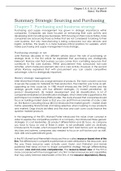Chapter 7, 8, 9, 10, 13, 14 and 15
Arjan J. Van Weele
Summary Strategic Sourcing and Purchasing
Chapter 7. Purchasing and business strategy
Purchasing and supply management has grown in strategic importance within
companies. Companies are more focused on enhancing their core activity and
developing and innovating new businesses. With focusing on their core activities, more
companies are outsourcing those activities that are not considered to belong to their
core business. Not only manufacturing is being outsourced, but also services and
logistic activities. This results in a more business-critical positions for suppliers, which
makes purchasing and supply management more strategic.
Purchasing strategic or not
John Ramsay discussed in two different articles about the role of purchasing on
strategic level. In the first article he explained that purchasing was strategically
irrelevant. Ramsay said that business success comes from controlling resources that
contribute to the core business. Within procurement they outsourced non-core
activities, which made procurement also not a core activity. However, in the second
article Ramsay explained that with procurement you can create competitive
advantage, which is strategically important.
History strategic management
After World War II there was a large demand of products. The main concern was how
to secure the supply for materials for their production. The intention was to be as self-
supporting as they could be. In 1980 Ansoff introduced the SWOT matrix and the
strategic growth matrix, with four different strategies; (1) market penetration, (2)
product development, (3) market development and (4) diversification. A lot of
companies embarked on diversification strategies, which were later supported by the
profit impact on market share (PIMS) studies. The study showed that companies should
focus on building market share so that you can profit from economies of scale. Later
on, the Boston Consulting Group (BCG) introduced the market growth – market share
matrix; spreading financial risks and being selective when investing in new products
and markets. Dogs should be killed and the stars and cash cows could finance the
question marked products.
In the beginning of the 80’s Michael Porter introduced the value chain concept in
order to explore the competitive position of a company. He introduced three generic
strategies: (1) cost leadership, (2) product differentiation and (3) focus. As company
you have to focus on one of these in order to be profitable. Later on, McKinsey
introduced its 7S model, which showed that apart form hard factors such as strategy,
structure and systems, companies also needed to focus on soft factors such as staff,
style, skills and superordinate goals.
In the 90’s Rumelt and Wernerfelt introduced the so-called resource-based view of the
firm. The differences in competitive performance were attributed to the resources and
the way these resources were actually used. Quinn and Prahalad and Hamel
published their ideas on how to shape competitive strategy through differentiating
between core and non-core competencies. The resource-based view of the firm is
more concerned with the management of a firm’s internal resources and capabilities
that may satisfy external stakeholders of the firm. In the resource dependency theory,
, Chapter 7, 8, 9, 10, 13, 14 and 15
Arjan J. Van Weele
the firm’s dependence on other external parties, such as suppliers, is central. The
stakeholder theory focuses on the diverse stakeholder perspectives a firm needs to
balance, weigh and respond to.
Designing purchasing and supply strategies
Monczka and Trent published extensively on the subject of designing purchasing and
supply strategies. The idea is to learn from ‘best-practices’. Companies should, when
pursuing purchasing excellence, pay attention to two kinds of processes: (1) strategic
management processes and enabling processes.
Strategic management processes
The goal is to integrate suppliers into the business processes. Depending on how
strategic a product is, the more energy and investments a company may be willing to
make to go through the full cycle.
1. Insourcing / outsourcing; Outsource the non-core activities, in-house activities
that belongs to the core business.
2. Develop commodity strategies; Develop a clear and detailed picture of its
purchasing spend.
3. Establish and leverage world class supply base management; How many
suppliers will be dealt with for a certain commodity, what conditions and
qualifications the best-in-class suppliers should meet and how the best suppliers
will be selected and contracted.
4. Develop and manage supplier relationships; Group the suppliers into distinctive
categories (commercial, preferred and partners).
5. Integration of suppliers in product development; Building constructive
relationships with suppliers in the area of new product development with
supplier partners.
6. Supplier integration; Integrating suppliers into Customer Focus Teams.
7. Supplier development and quality management; suppliers are actively
challenged to provide new ideas for improvement.
8. Strategic cost management; reducing and eliminating costs throughout supply
chain.
Enabling processes
Besides the management processes, purchasing managers need to give attention to
enabling processes as well following the view of Monczka;
1. Establish globally integrated and aligned purchasing and supply-chain
strategies and plans; outlining the business strategy to the different units of the
business.
2. Develop organization and teaming strategies; cross-functional teamwork is
important. Share the purchasing plans and strategies.
3. Deploy globalization; use different countries and cultures for purchasing.
4. Develop purchasing and supply-chain measurements; report the management
through well-chosen key performance indicators.
5. Develop and implement enabling IS/IT systems; integrate purchasing
information with the ERP systems.
6. Establish human resource development and training; a company is as good as
the people that work for it.
The differentiation between strategic management and enabling processes is that
both need to be conducted in parallel in a company.






